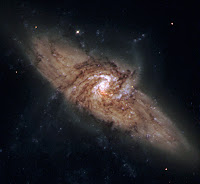
Astronomy Picture of the Day (APOD) brings us this photo (click on the photo at right for a larger view) of two galaxies that just happen to line up from our perspective on Earth. This has some scientific benefits (see below), but what strikes me as I look at this is simply the sheer beauty of it. And also what seems like a vanishingly small chance that something like this could "just happen", and how fortunate we are to live in an age where such things can be discovered and shared. The explanation from APOD:
NGC 3314 consists of two large spiral galaxies which just happen to almost exactly line-up. The foreground spiral is viewed nearly face-on, its pinwheel shape defined by young bright star clusters. But against the glow of the background galaxy, dark swirling lanes of interstellar dust are also seen to echo the face-on spiral's structure. The dust lanes are surprisingly pervasive, and this remarkable pair of overlapping galaxies is one of a small number of systems in which absorption of visible light can be used to directly explore the distribution of dust in distant spirals. NGC 3314 is about 140 million light-years away in the multi-headed constellation Hydra. This color composite was constructed from Hubble Space Telescope images made in 1999 and 2000.



